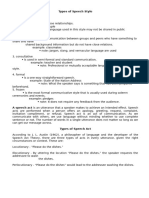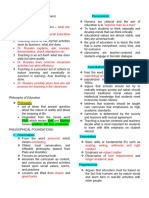0 ratings0% found this document useful (0 votes)
15 viewsUnit 2 Handout
This document discusses speech context, speech style, speech acts, and performatives. It defines speech context as the environment and circumstances of communication, including social setting and relationships. Speech style is affected by context and includes intimate, casual, consultative, formal, and frozen styles. The document also defines speech acts as utterances used to achieve effects, like requests or apologies. Specifically, it discusses locutionary, illocutionary, and perlocutionary acts. Finally, it explains that performatives are statements that perform an action through being stated by an authorized person, like pronouncing a couple married.
Uploaded by
Ray John NoolCopyright
© © All Rights Reserved
Available Formats
Download as PDF, TXT or read online on Scribd
0 ratings0% found this document useful (0 votes)
15 viewsUnit 2 Handout
This document discusses speech context, speech style, speech acts, and performatives. It defines speech context as the environment and circumstances of communication, including social setting and relationships. Speech style is affected by context and includes intimate, casual, consultative, formal, and frozen styles. The document also defines speech acts as utterances used to achieve effects, like requests or apologies. Specifically, it discusses locutionary, illocutionary, and perlocutionary acts. Finally, it explains that performatives are statements that perform an action through being stated by an authorized person, like pronouncing a couple married.
Uploaded by
Ray John NoolCopyright
© © All Rights Reserved
Available Formats
Download as PDF, TXT or read online on Scribd
You are on page 1/ 1
ORAL COMMUNICATION IN CONTEXT UNIT II (Speech Context, Speech Style, Speech Act)
SPEECH CONTEXT PERFORMATIVES
Speech context is the environment and the circumstances The concept of performative utterances: statements which
in which a communication happens. It includes the social enable the speaker to perform something just by stating it.
setting, the status, and the relationship of the participants, In this manner, verbs that execute the speech act that they
and the way the message is delivered. intend to effect are called performatives. A performative
Types of Speech Context utterance said by the right person under the right
1. Intrapersonal – This refers to communication that circumstances results in a change in the world. Note that
centers on one person where the speaker acts both certain conditions have to be met when making a
as the sender and the receiver of message. performative utterance.
2. Interpersonal – This refers to communication For example, the phrase “I now pronounce you husband and
between and among people and establishes wife,” when uttered by an authorized person such as a
personal relationship between and among them. judge will have the actual effect of binding a couple in
Dyad Communication – communication marriage. However, if the same statement is uttered to the
that occurs between two people. same couple in the same place by someone who is not
Small Group – This refers to authorized to marry them—as in the case of the
communication that involves at least three accompanying picture, a robot—then there is no effect
but not more than twelve people engaging whatsoever because a condition was not met.
in a face-to-face interaction to achieve a SEARLE’S CLASSIFICATIONS OF SPEECH ACT
desired goal. 1. Assertive – a type of illocutionary act in which the
3. Public – This type refers to communication that speaker expresses belief about the truth of a
requires you to deliver or send the message before proposition. Some examples of an assertive act are
or in front of a group. suggesting, putting forward, swearing, boasting,
4. Mass Communication – This refers to and concluding.
communication that takes place through Example: No one makes better pancakes than I do.
television, radio, newspapers, magazines, books, 2. Directive – a type of illocutionary act in which the
billboards, internet, and other types of media. speaker tries to make the addressee perform an
SPEECH STYLE action. Some examples of a directive act are asking,
The context dictates and affects the way people ordering, requesting, inviting, advising, and
communicate, which results in various speech styles. begging.
Types of Speech Style Example: Please close the door.
1. Intimate – This style is private, which occurs 3. Commissive – a type of illocutionary act which
between or among close family members or commits the speaker to doing something in the
individuals. The language used in this style may not future. Examples of a commissive act are
be shared in public. promising, planning, vowing, and betting.
2. Casual – This style is common among peers and Example: From now on, I will participate in our
friends. Jargon, slang, or the vernacular language group activity.
are used. 4. Expressive – a type of illocutionary act in which the
3. Consultative – This style is the standard one. speaker expresses his/her feelings or emotional
Professional or mutually acceptable language is a reactions. Some examples of an expressive act are
must in this style. thanking, apologizing, welcoming, and deploring.
4. Formal – This style is used in formal settings. Unlike Example: I am so sorry for not helping out in our
the consultative style, this is one-way. group projects and letting you do all the work.
5. Frozen – This style is “frozen” in time and remains 5. Declaration – a type of illocutionary act which
unchanged. It mostly occurs in ceremonies. brings a change in the external situation. Simply
Common examples are the Preamble to the put, declarations bring into existence or cause the
Constitution, Lord’s Prayer, and Allegiance to state of affairs which they refer to. Some examples
country or flag. of declarations are blessing, firing, baptizing,
SPEECH ACTS bidding, passing a sentence, and excommunicating.
A speech act is an utterance that a speaker makes to Example: You are fired!
achieve an intended effect. Some of the functions By saying that someone is fired, an employer
which are carried out using speech acts are offering an causes or brings about the person’s
apology, greeting, request, complaint, invitation, unemployment, thus changing his external
compliment, or refusal. situation.
3 Types of Speech Acts
1. Locutionary act is the actual act of uttering. Always keep in mind that speech acts include
“Please do the dishes.” concrete life interactions that require the
2. Illocutionary act is the social function of what is appropriate use of language within a given culture.
said. Communicative competence (i.e., the ability to use
By uttering the locution “Please do the dishes,” the linguistic knowledge to effectively communicate
speaker requests the addressee to wash the dishes. with others) is essential for a speaker to be able to
3. Perlocutionary act is the resulting act of what is use and understand speech acts. Idioms and other
said. This effect is based on the particular context nuances in a certain language might be lost or
in which the speech act was mentioned. misunderstood by someone who does not fully
“Please do the dishes” would lead to the addressee grasp the language yet.
washing the dishes.
Compiled Handout by J.Nool
You might also like
- First Midterm Examination in Oral Communication 11No ratings yetFirst Midterm Examination in Oral Communication 116 pages
- Oral Com - Lesson 3 Communicative Competence Strategies in Various Speech SituationNo ratings yetOral Com - Lesson 3 Communicative Competence Strategies in Various Speech Situation39 pages
- The Different Types of Speech Context and Speech StyleNo ratings yetThe Different Types of Speech Context and Speech Style2 pages
- Oral Communication in Context Unit Iii PageNo ratings yetOral Communication in Context Unit Iii Page6 pages
- Lesson3&4 Types of Speech Context and StyleNo ratings yetLesson3&4 Types of Speech Context and Style31 pages
- Intercultural Communication Speech Act Style Context1No ratings yetIntercultural Communication Speech Act Style Context11 page
- LECTURE-NOTES-LESSON-10-11-COMMUNICATIVE-STRATEGIES-AND-SPEECH-ACTSNo ratings yetLECTURE-NOTES-LESSON-10-11-COMMUNICATIVE-STRATEGIES-AND-SPEECH-ACTS2 pages
- STEM 11 - Oral Communication 1st Semester, 2nd Quarter NotesNo ratings yetSTEM 11 - Oral Communication 1st Semester, 2nd Quarter Notes6 pages
- Oral Communication in Context: Self-Learning ModulesNo ratings yetOral Communication in Context: Self-Learning Modules11 pages
- Antipolo City Senior High School: Republic of The Philippines Department of Education Region Iv-A Calabarzon District I-ANo ratings yetAntipolo City Senior High School: Republic of The Philippines Department of Education Region Iv-A Calabarzon District I-A4 pages
- On The Use Non-Stationary Penalty Functions T o Solve Nonlinear Constrained Optimization Problems With GA'sNo ratings yetOn The Use Non-Stationary Penalty Functions T o Solve Nonlinear Constrained Optimization Problems With GA's6 pages
- Barnardos Domestic Violence Risk Identification Matrix-2No ratings yetBarnardos Domestic Violence Risk Identification Matrix-21 page
- Badri Engineering Corporation: One Stop Shop For All Your Industrial NeedsNo ratings yetBadri Engineering Corporation: One Stop Shop For All Your Industrial Needs2 pages
- Influence: Science and Practice by Robert CialdiniNo ratings yetInfluence: Science and Practice by Robert Cialdini12 pages
- Table of Specifications (Tos) : Schools Division of Samar Baras National High SchoolNo ratings yetTable of Specifications (Tos) : Schools Division of Samar Baras National High School7 pages
- LESSON-3 History of Global Politics Creating An International Order100% (1)LESSON-3 History of Global Politics Creating An International Order40 pages
- Affinity Laws For Variable Speed Centrifugal PumpsNo ratings yetAffinity Laws For Variable Speed Centrifugal Pumps4 pages
- Senior Engineer (Technical Lead) - Engineering-RomaniaNo ratings yetSenior Engineer (Technical Lead) - Engineering-Romania2 pages
- Q2 - M2 - Current and Future Trends in Media and InformationNo ratings yetQ2 - M2 - Current and Future Trends in Media and Information32 pages
- Insert OJT Provider Name Here: LWDA 12: On-the-Job Training (OJT) Training PlanNo ratings yetInsert OJT Provider Name Here: LWDA 12: On-the-Job Training (OJT) Training Plan3 pages

























































































